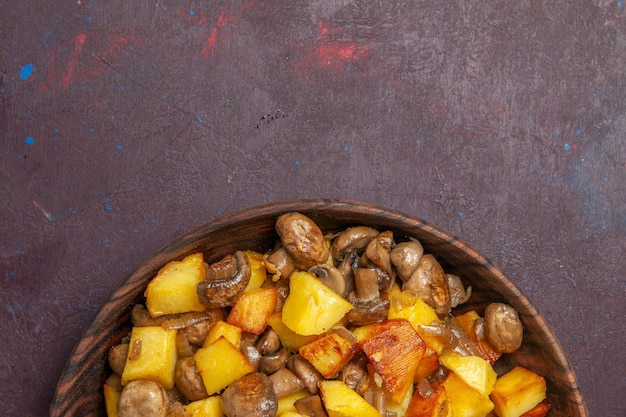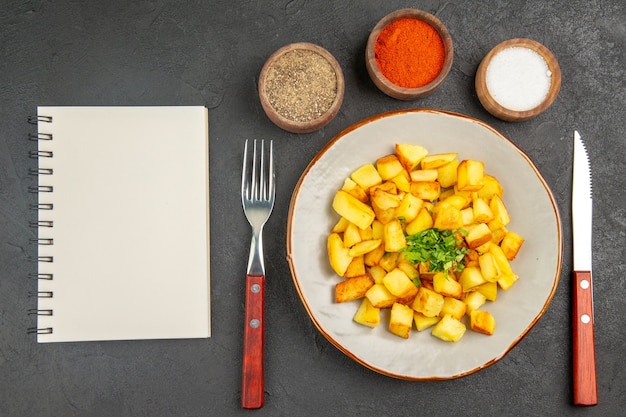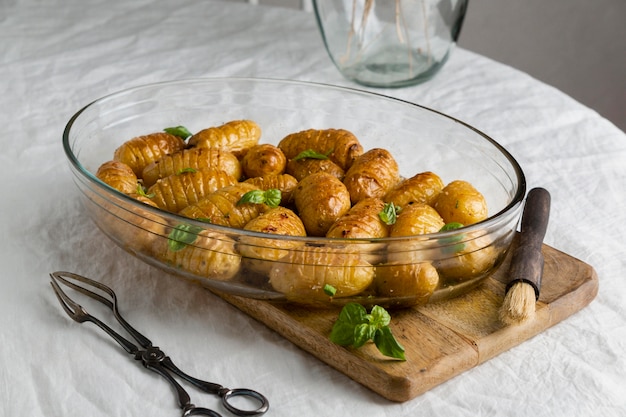Let's talk about rutabagas. Now, I know what you're thinking: "Rutabagas? Really? They're just those big, knobbly, kinda boring root vegetables, right?" And, well, you're not entirely wrong. They're not the most glamorous ingredient, but trust me, they have so much potential! When cooked right, they're absolutely delicious – sweet, nutty, and surprisingly versatile.
Over the years, I've discovered that rutabagas are a bit like a hidden gem in the world of vegetables. They're not always the star of the show, but when you know how to work with them, they can truly shine. And that's what I'm here to help you with. This is your ultimate guide to cooking delicious rutabagas, packed with tips, tricks, and recipes that will make you reconsider your perception of this often overlooked vegetable.
(Part 1) Getting to Know the Rutabaga

What is a Rutabaga?
Rutabagas, also known as "swede" in some parts of the world, are root vegetables that are a cross between a turnip and a cabbage. They're actually a hybrid vegetable, created by accident centuries ago when a turnip and a cabbage crossed paths. The result is a unique vegetable with its own distinctive flavour profile and texture.
They have a firm, pale yellow flesh and a slightly sweet, earthy flavour. The skin can be quite tough, so it's always best to peel it before cooking. If you're unsure about the difference between a rutabaga and a turnip, a good rule of thumb is that rutabagas tend to be larger and more rounded than turnips.
The Nutritional Value of Rutabagas
Rutabagas are a nutritional powerhouse! They're packed with vitamins, minerals, and antioxidants. Their rich yellow colour is a sign of their high vitamin C content, which is a powerful antioxidant that helps boost your immune system. Just one cup of cooked rutabaga provides a good amount of vitamin C, potassium, and fiber. They're also a good source of folate, which is essential for cell growth and development, and particularly important for pregnant women.
Choosing the Right Rutabaga
The best rutabagas are firm, heavy for their size, and have smooth, unblemished skin. Think of them like a good melon – you want a heavy one for its size, indicating juicy flesh. Avoid any that have soft spots, cracks, or signs of rot. If you see any green patches on the skin, it's a sign that the rutabaga has been exposed to sunlight, which can make the flesh taste bitter.
Storing Rutabagas
Rutabagas can be stored in a cool, dry place for up to 2 weeks. For longer storage, you can store them in the refrigerator for up to a month. The best way to store them is to wrap them tightly in plastic wrap or a reusable produce bag to prevent them from drying out.
(Part 2) Preparing Rutabagas for Cooking

Peeling and Chopping
Use a sharp knife to peel the rutabaga, discarding the tough outer layer. I find it easier to remove the skin in strips rather than trying to peel it all at once. This also prevents too much of the precious flesh from being discarded. After peeling, cut the rutabaga into chunks or slices, depending on the recipe. If you're making a roasted rutabaga dish, larger chunks are great for getting that caramelized exterior. But for soups, stews, or mashed rutabagas, smaller cubes will cook more evenly.
Blanching
Blanching is a great way to soften rutabagas before roasting or grilling. It also helps to preserve their colour. To blanch, simply submerge the cut rutabaga in boiling water for 2-3 minutes, then drain and refresh in cold water. This shock of cold water stops the cooking process and helps to maintain the vibrant yellow colour.
Tips for Keeping Your Rutabagas Bright
Rutabagas have a tendency to turn grey or brown when exposed to air. This is due to oxidation, a natural process that happens when vegetables are exposed to oxygen. To prevent this, add a little lemon juice or vinegar to the water when blanching. The acid in these ingredients helps to prevent oxidation and preserve the bright yellow colour of the rutabaga.
(Part 3) Cooking Rutabagas: Roasting, Mashing, and More!

Roasting Rutabagas
Roasted rutabagas are a real treat! Their sweetness intensifies in the oven, and their texture becomes tender and slightly caramelized. It's a simple but delicious way to showcase the natural sweetness of this root vegetable. Here's what I do:
- Preheat your oven to 200°C (400°F).
- Toss the chopped rutabaga with olive oil, salt, and pepper. Olive oil adds a richness and helps to create a crispy exterior. Salt and pepper are essential for enhancing the flavour.
- Spread the rutabaga in a single layer on a baking sheet. This ensures even cooking and browning.
- Roast for 30-40 minutes, or until tender and lightly browned. You'll know it's ready when it's easily pierced with a fork.
- I like to add a sprinkle of fresh herbs like rosemary or thyme to the roasting pan for an extra burst of flavour. Herbs like rosemary and thyme complement the earthy sweetness of the rutabaga.
Mashed Rutabagas
Mashed rutabagas are a great alternative to mashed potatoes. They're creamy, flavorful, and a great way to sneak some extra vegetables into your meal. The texture is slightly denser than mashed potatoes, but just as comforting. Here's how I make them:
- Boil the chopped rutabaga in salted water until tender, about 20-25 minutes. Use salted water to season the rutabaga as it cooks.
- Drain the rutabaga and mash with butter, milk, and salt and pepper to taste. Butter adds richness, while milk creates a smooth and creamy texture. Seasoning is crucial for bringing out the flavour.
- You can also add a little nutmeg or cinnamon for a touch of warmth. These spices complement the earthy sweetness of the rutabaga and add a layer of complexity.
Adding Rutabagas to Soups and Stews
Rutabagas add a wonderful sweetness and depth of flavour to soups and stews. They work well with a variety of flavours, from hearty beef stews to creamy vegetable soups. I love adding rutabagas to my lentil soup - it brings a beautiful contrast of textures and a touch of sweetness. The sweetness of the rutabaga balances the earthy flavour of the lentils.
Sautéed Rutabagas
Sautéed rutabagas are a quick and easy side dish that can be enjoyed on its own or served alongside other roasted vegetables. They're a great way to showcase the natural sweetness and flavour of the rutabaga. Just sauté the chopped rutabaga in a pan with olive oil, garlic, and onions until tender and slightly caramelized.
Rutabaga Fritters
Rutabaga fritters are a fun and flavorful way to enjoy this versatile vegetable. They're crispy on the outside and soft and fluffy on the inside. Here's a basic recipe:
- Grate the rutabaga and combine it with flour, eggs, and seasonings. Grated rutabaga provides a fine texture for the fritters. The flour acts as a binder, while the eggs add moisture and richness. Seasonings can be customized to your taste.
- Drop spoonfuls of the batter into hot oil and fry until golden brown. This creates a crispy exterior while keeping the interior tender.
- Serve the fritters with a dollop of sour cream or aioli. These toppings provide a cool and creamy contrast to the warm, crispy fritters.
Rutabaga Gratin
Rutabaga gratin is a decadent and satisfying dish that's perfect for a special occasion. The rutabaga is thinly sliced and layered with cheese and herbs before being baked in the oven until golden and bubbly. It's a visually appealing dish that's sure to impress.
(Part 4) Delicious Rutabaga Recipes
Roasted Rutabagas with Herbs and Parmesan
Ingredients:
- 1 large rutabaga, peeled and cubed
- 2 tablespoons olive oil
- 1 teaspoon salt
- 1/2 teaspoon black pepper
- 1 tablespoon fresh rosemary, chopped
- 1 tablespoon fresh thyme, chopped
- 1/4 cup grated Parmesan cheese
Instructions:
- Preheat oven to 200°C (400°F).
- In a large bowl, toss the rutabaga with olive oil, salt, pepper, rosemary, and thyme. This coats the rutabaga evenly with flavour and helps it to cook evenly.
- Spread the rutabaga in a single layer on a baking sheet. This prevents the rutabaga from steaming and ensures that it roasts evenly.
- Roast for 30-40 minutes, or until tender and lightly browned. Check the rutabaga with a fork to ensure it's tender.
- Sprinkle with Parmesan cheese in the last 5 minutes of cooking. The Parmesan cheese melts and forms a golden crust on top of the rutabaga.
Creamy Mashed Rutabagas with Nutmeg
Ingredients:
- 1 large rutabaga, peeled and cubed
- 1/2 cup milk
- 2 tablespoons butter
- 1/4 teaspoon salt
- 1/8 teaspoon black pepper
- 1/4 teaspoon ground nutmeg
Instructions:
- Boil the rutabaga in salted water until tender, about 20-25 minutes. The rutabaga should be easily pierced with a fork.
- Drain the rutabaga and mash with butter, milk, salt, pepper, and nutmeg. Mash the rutabaga until smooth and creamy.
- Serve immediately. The mashed rutabagas are best served hot and fresh.
Hearty Beef Stew with Rutabagas and Carrots
Ingredients:
- 1 pound beef chuck roast, cut into 1-inch cubes
- 1 tablespoon olive oil
- 1 onion, chopped
- 2 carrots, chopped
- 1 rutabaga, peeled and cubed
- 2 cups beef broth
- 1/2 cup red wine
- 1 teaspoon salt
- 1/2 teaspoon black pepper
- 1 bay leaf
Instructions:
- In a large dutch oven or pot, heat olive oil over medium heat.
- Add the beef and cook until browned on all sides. This creates a rich flavour and a beautiful colour.
- Add the onion, carrots, and rutabaga and cook for 5 minutes, or until softened. The vegetables should soften but not brown.
- Pour in the beef broth, red wine, salt, pepper, and bay leaf. Beef broth adds depth of flavour, while red wine adds a hint of acidity. Salt and pepper are essential for seasoning the stew, while the bay leaf adds a subtle warmth.
- Bring to a boil, then reduce heat and simmer for 2-3 hours, or until the beef is tender. The longer you simmer the stew, the more tender the beef will become.
- Serve hot. The beef stew is best served with a crusty bread for dipping.
Rutabaga Fritters with Apple Sauce
Ingredients:
- 1 large rutabaga, peeled and grated
- 1/2 cup all-purpose flour
- 1 egg, beaten
- 1/4 teaspoon salt
- 1/4 teaspoon black pepper
- 1/4 teaspoon ground nutmeg
- 1/4 cup vegetable oil
- Apple sauce, for serving
Instructions:
- In a large bowl, combine the grated rutabaga, flour, egg, salt, pepper, and nutmeg. This creates a thick batter for the fritters.
- Heat the vegetable oil in a large skillet over medium heat. The oil should be hot enough to sizzle when you add the batter.
- Drop spoonfuls of the batter into the hot oil and fry for 3-4 minutes per side, or until golden brown. The fritters should be crispy on the outside and soft on the inside.
- Serve the fritters with a dollop of apple sauce. The sweetness of the apple sauce complements the earthy flavour of the rutabaga.
Rutabaga Gratin with Gruyère Cheese and Thyme
Ingredients:
- 1 large rutabaga, peeled and thinly sliced
- 1/4 cup butter
- 1/4 cup all-purpose flour
- 2 cups milk
- 1/2 teaspoon salt
- 1/4 teaspoon black pepper
- 1/4 teaspoon ground nutmeg
- 1 cup grated Gruyère cheese
- 1 tablespoon fresh thyme, chopped
Instructions:
- Preheat oven to 180°C (350°F).
- In a large saucepan, melt the butter over medium heat. The butter should be melted but not browned.
- Whisk in the flour and cook for 1 minute. This creates a roux, which will thicken the sauce.
- Gradually whisk in the milk until smooth. Add the milk slowly to prevent the sauce from becoming lumpy.
- Bring to a simmer, stirring constantly. The sauce should simmer gently but not boil.
- Season with salt, pepper, and nutmeg. This adds depth of flavour to the sauce.
- Remove from heat and stir in the Gruyère cheese and thyme. The cheese will melt into the sauce and add a richness and flavour.
- Pour the cheese sauce into a greased 9x13 inch baking dish. The sauce should be evenly distributed in the dish.
- Arrange the rutabaga slices in a single layer on top of the sauce. The rutabaga slices should be overlapping slightly.
- Bake for 30-40 minutes, or until the rutabaga is tender and the cheese is melted and bubbly. The cheese should be golden brown and bubbly.
(Part 5) Tips for Cooking Rutabagas Like a Pro
Here are a few extra tips to help you cook rutabagas like a pro:
- Don't overcook the rutabagas. Overcooked rutabagas will become mushy and lose their flavour. The rutabaga should be tender but still have a bit of bite.
- To add a bit of sweetness, you can glaze the roasted rutabagas with honey or maple syrup in the last 5 minutes of cooking. The honey or maple syrup will caramelize and create a sticky glaze.
- Get creative with your seasonings! Rutabagas pair well with a variety of herbs and spices, including rosemary, thyme, sage, nutmeg, cinnamon, and ginger. Experiment to find your favourites! Try using a combination of herbs and spices for a complex flavour profile.
- If you're short on time, you can use pre-cut rutabagas from the grocery store. Just make sure to check the ingredients list to avoid any unwanted additives. Some pre-cut vegetables may have added preservatives or seasonings.
- Rutabagas can be frozen for later use. Simply blanch the chopped rutabaga for a few minutes, then drain and freeze in airtight containers. Frozen rutabaga can be used in soups, stews, or other dishes where it will be cooked thoroughly.
(Part 6) Rutabagas Beyond the Kitchen
Did you know that rutabagas can be used for more than just cooking? Here are a few unexpected uses for this versatile root vegetable:
- Dyeing Fabric: Rutabagas can be used to create a beautiful yellow dye for fabrics. The juice of the rutabaga can be used to dye natural fibres like wool or cotton.
- Making Candles: The juice of rutabagas can be used to make natural candles. The juice can be combined with beeswax or soy wax to create a unique and fragrant candle.
- Gardening: The leaves of rutabagas can be used as a natural fertilizer for your garden. The leaves are rich in nutrients and can be added to your compost pile or used as a mulch.
(Part 7) FAQs
Q1: Can I use rutabagas in place of potatoes?
Absolutely! Rutabagas are a great substitute for potatoes in many recipes. They have a slightly milder flavour than potatoes, but they can be just as satisfying. Try using rutabagas in mashed potato recipes, potato salads, or even potato chips. The rutabaga's sweetness and earthy flavour add a unique twist to these classic dishes.
Q2: What are some good ways to add sweetness to rutabagas?
Adding a touch of sweetness to rutabagas can really enhance their flavour. You can glaze them with honey, maple syrup, or even a sprinkle of brown sugar. Adding a bit of apple cider vinegar or lemon juice can also help to bring out the sweetness. The acidity of these ingredients helps to balance the sweetness and create a more complex flavour profile.
Q3: How can I prevent rutabagas from turning grey?
To prevent rutabagas from turning grey, be sure to add a little lemon juice or vinegar to the water when blanching them. You can also try storing them in an airtight container with a piece of apple or a piece of paper towel soaked in lemon juice. These methods help to prevent oxidation and preserve the rutabaga's bright yellow colour.
Q4: What's the difference between a rutabaga and a turnip?
Rutabagas and turnips are both root vegetables, but they have a few key differences. Rutabagas are larger and have a smoother, more rounded shape. They also have a slightly sweeter flavour than turnips. Turnips are smaller and more bulbous, with a more peppery flavour. While they're both root vegetables, their distinct flavours and textures make them suitable for different dishes.
Q5: Are rutabagas good for you?
Yes, rutabagas are very good for you! They're packed with nutrients, including vitamins, minerals, and antioxidants. They're also a good source of fiber. Incorporating rutabagas into your diet can contribute to a healthy and balanced lifestyle.
(Part 8) Final Thoughts
So, there you have it! The ultimate guide to cooking delicious rutabagas. I hope this has inspired you to give this versatile vegetable a chance. It might not be the most glamorous ingredient, but it's certainly a delicious one. With a little creativity and a few simple tips, you can transform this humble root vegetable into a culinary masterpiece. Enjoy!
Everyone is watching

How to Cook Frozen Lobster Tails Perfectly: A Step-by-Step Guide
RecipesLobster. Just the word conjures up images of lavish meals, special occasions, and a taste of luxury. But let's...

Pigs in a Blanket Cooking Time: How Long to Bake for Perfect Results
RecipesAh, pigs in a blanket. Just the name conjures up images of those delightful little parcels of crispy pastry en...

Pork Fillet Cooking Time: How Long to Cook It Perfectly
RecipesPork fillet, or tenderloin as it's sometimes called, is a real favourite in our house. It's so versatile, and...

The Ultimate Guide to Tender, Juicy Pulled Pork
RecipesRight, let's talk pulled pork. It's one of those dishes that just screams "comfort food," doesn't it? I mean...

The Ultimate Guide to Cooking Delicious Frankfurters
RecipesLet's face it, we all love a good frankfurter. It's a classic, simple, and always satisfying. But let's be rea...
